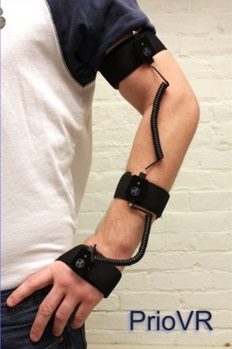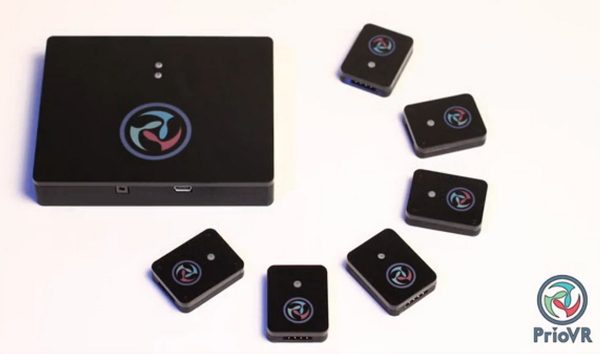With yesterday’s launch of the PrioVR Kickstarter, we had a few questions about the system. We got in touch with Paul Yost, Chief of R&D at YEI Technology, to get answers straight from the source. Read on for our Q&A.
PrioVR, which has already raised $20,000 (9%) of its Kickstarter goal on day one, is an affordable full body motion capture suit which hopes to put your entire body into virtual reality games.
PrioVR Q&A With Paul Yost, Chief of R&D at YEI Technology
 Road to VR: What kind of battery life will you aim for on PrioVR?
Road to VR: What kind of battery life will you aim for on PrioVR?
Paul Yost: We’re aiming for 8-10 hours of continuous use with the default battery. For extending this, we’re also planning on supporting external battery-life extenders like those used for cell-phones and tablets. The system can also be used continuously while it is charging, albeit you’d be tethered while charging.
Road to VR: What is PrioVR’s effective range?
Yost: Right now, the theoretical range is calculated at 100m, but in practice and in environments that have other RF traffic, the effective range is in the 30m-40m range line-of-sight, which is enough for most home-use setups. We’re investigating adding a low-noise amplifier section and a high-gain antenna option to the wireless base-station design to allow for improvement of the range. Also, the way the system works, it is possible to distribute multiple wireless base-station units across a wide area to achieve very large active areas.
Road to VR: Can an IMU-based system like PrioVR provide globally accurate positioning without drift? Oculus has said that positional head tracking with IMUs alone cannot be done without drift.
Yost: There is a bit of a misconception here with regards to drift-free “globally accurate positioning”. Having a position that is globally accurate in real-world-space is irrelevant to perception within the virtual world-space. In fact, having a real-world-accurate position can be detrimental to immersion — imagine that in the virtual world that you are sliding down a slippery slope — what matters here is that you are seeing out of the eyes of your virtual avatar accurately within that virtual world and that movements you make in the virtual world are accurate for that world.
The problem with Oculus maintaining a drift-free position is that they only have one sensor in the HMD itself. Thus without sensors on the other body parts, the head-sensor is disembodied and therefore not rooted to anything within the virtual world which means that if the user leans or peers forward without changing the head orientation, the sensor cannot detect this movement.
The PrioVR system, however, can detect this movement because any movement, however subtle, causes skeletal changes that can be detected by the other sensors. Thus, the PrioVR system maintains a drift-free position within the virtual world just like you maintain your position within the real world, by virtual body parts coming in contact with virtual surfaces within the virtual world and the friction of those points of contact rooting the avatar in place virtually. So, once you have a complete body pose, the virtual head is no longer disembodied since it is rooted to a body which is rooted to the virtual world according to that world’s physics rules. Our current system is based upon this virtual-pedestrian body tracking technique. It works very well and feels amazingly natural as you move through the virtual world.
Road to VR: How is PrioVR different than other IMU-based motion capture systems?
PrioVR… outperforms these professional systems in many ways, but is priced starting in the sub $500 range
Yost: The first difference is the price-point. Current professional-grade inertial motion-capture systems cost $60,000 to $80,000 dollars. The PrioVR is creating technology that outperforms these professional systems in many ways, but is priced starting in the sub $500 range.
Secondly, we’re shooting for ease-of-use and ease-of-adoption across a wide range of systems, projects, and, hopefully, titles. We’re doing this by providing APIs, software tools, easy to use drop-in support for major game engines, and open-source demos. Our goal is to make it ridiculously easy to get the PrioVR into any project.
Third, is that we’ve spent the last five years researching inertial sensors and have built this suite of patents that allow us to achieve very high accuracy results at very high-output rates. We’re attaining performance levels in our low-cost PrioVR sensor technology that rival the performance of military-use IMUs that are in the $1500 to $2500 range per sensor. To put that into perspective, our ready-to-use suit that consists of 17 sensors plus all the other stuff will be priced at about 1/4th the cost of a just a single sensor from competitors.
Road to VR: What is the latency for the 3-Space sensors [YEI’s previous low-cost sensor family]? Is it expected to change with PrioVR?
Yost: The latency for a single wireless 3-Space Sensor is in the 4-6ms range. The problem with our existing wireless sensors as used for motion-capture purposes is that it takes 17 of these sensors all streaming simultaneously which causes an increased likelihood of RF collisions as more bandwidth is used. That said, we’ve set-up and used several suits at once (you can see this in the video) and can still achieve good results, but the latency increases as the number of sensors increases due to bandwidth saturation.
The PrioVR system solves this by using a single transmitter in the wearable wireless-hub unit. The preliminary tests we’ve done we’ve been able to achieve latencies of the PrioVR suit that are in the sub 10ms range across all 17 sensors ( and we have yet to work on optimization ). To put this into perspective, the original Kinect has a latency of 90ms and the KinectOne has been reported to have a latency of 60ms. Additionally we’ve projected that using this architecture we can support dozens of simultaneous suits while maintaining comfortable usability.
Road to VR: Why are cables added to the system over the 3-Space system?
The final system… will consist of an easy to wear vest or light-weight harness that connects to wired sensors strips that attach to the arms and legs.
Yost: First, it must be made clear that neither system shown is the final system. This probably should have been made more clear in the Kickstarter campaign information. Our goal is to make the system as easy to use and wear at the best possible price-point. The final system, however, will consist of an easy to wear vest or light-weight harness that connects to wired sensors strips that attach to the arms and legs. The main reason to add the wires (or some sort of physical connection) is to reduce cost as much as possible.
In order to have each node be a self-contained wireless unit involved unavoidable repeated costs across every sensor as every wireless sensor requires a wireless transceiver, an antenna solution, a LiPo battery, circuitry for charge management, and circuitry for battery level monitoring. Additionally, such a system would require all the sensors to be charged in a docking station or some-such device, which would also add to the cost. All this additional redundant circuitry and components adds cost, complexity, and size.
The second reason for the wired system is to reduce the latency of the system as much as possible and to preserve bandwidth to allow for many suits to be used simultaneously. Again, the final form-factor will likely be an easy to wear vest or light-weight harness with a small number of sensor strips attached.
Road to VR: What has changed since the 3-Space system that’s allowed you to reduce the price so significantly?
Yost: The main changes are the removal of redundant wireless, battery, charging circuitry, and battery monitoring circuitry. Additionally, we spent several months focusing on value-engineering every aspect of the entire system without compromising performance. In many cases even saving 1/10th of a cent here and there adds up, especially when you have 17 sensors that you’re repeating that savings across.
Road to VR: How will each node be charged?
Yost: With the new centralized wearable wireless hub architecture, each node will no longer be charged. The battery will be in the wearable hub and only it will need to be charged. The system can also be powered from an external source and used continuously or while charging.
Road to VR: Is 11 or 17 node tracking necessary for VR gaming? Would sensors on the hands, feet, and head not be enough for full body immersion?
Yost: It depends upon the level of accuracy that is required. The 11 sensor version works well for most applications, and a smaller number could be used, but, especially with VR applications, it is important for the virtual body to mimic the movements of your physical body in order to preserve the illusion of immersion. So, 11 sensors works well for this and 17 sensors works amazingly well.
Road to VR: Do you see Sixense STEM as a direct competitor or a complimentary peripheral?
Yost: Certainly there are some aspects of the two systems doing similar things, but the two technologies each have different advantages and disadvantages. Their technology can sense position in the real-world space accurately, while ours accurately preserves the illusion of immersion within the virtual world due to a highly accurate 1-to-1 matching of the player pose with the virtual avatar pose.
The Sixense STEM technology requires a limited capture area due to the need of the magnetic base station, while our system can be used anywhere freely, even in essentially limitless capture spaces. Additionally the STEM has a limit of 5 tracking points, which cannot ever be used to fully capture the pose of the player. For a totally immersive experience that preserves the illusion of a virtual reality, you need to be able to look at your virtual body and have it match your proprioceptive feeling. You can’t do that with just 5 sensors. What might make for the best experience would be hybrid system that can track position using the STEM and full body pose using PrioVR sensors.
—–
Thanks to Paul Yost for answering our questions! If you’ve got additional questions, drop them in the comments below and we’ll see what we can do to get them answered.








